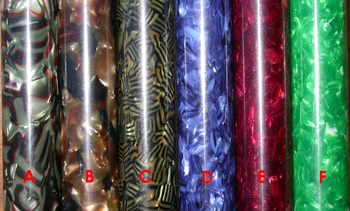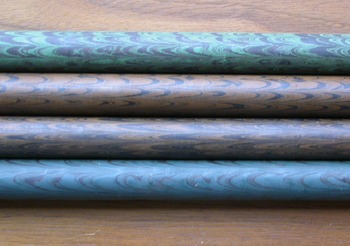Materials
One of the more difficult tasks for a modern custom pen maker is to find good materials. We all want something unique, yet the investments in manufacturing custom materials can often be prohibitive.
The more common materials used in modern pens are acrylic and hard rubber, although there are less commonly available materials, such as celluloid, bakelite, casein, polyester, etc. When a pen maker can get his hands on some quality vintage material, new options present themselves. But of course, there just isn't that much around.
Check the Links page for material suppliers.
Acrylics
Celluloid
Hard Rubber
Casein
Other Materials
"Acrylics"
There are many compositions of plastics and I wouldn't even dare to discuss their properties or differences. For this category, I'll basically use the term "acrylics" as a catch-all to cover a group of common pen making materials such as acrylic acetate, polyesters, lucite, etc.
Acrylics are the most commonly available materials and can be acquired in a plethora of colors and patterns. Many of the modern acrylic pen blanks are manufactured in Taiwan, and sold through various suppliers. Acrylics are hard, polish well and generally resistant to staining.
I've made a number of pens in acrylic patterns. In general, I find them far more "modern" in appearance — they just don't look quite like the older materials. Some pens, though, are best done with acrylics, especially clear demonstrators or others where full transparency is desired.
The picture here shows an array of Mazzucchelli produced stock that was used by Sheaffer during the late 1990s. I've made pens from most of these materials, but still have a supply left.

Celluloid (Cellulose Nitrate)
When I say celluloid, I mean cellulose nitrate, not cellulose acetate. Yes, celluloid is a plastic, but when it comes to pen making, it's in a category by itself. The celluloid materials are versatile in their patterns and can be quite stunning. Unfortunately, they are also far more difficult and expensive to manufacture. For this reason, they are generally hard to find.
Hard Rubber
My favorite material for a pen is hard rubber. After all, this was the material of choice (and necessity?) through the first quarter of the 20th century. Early hard rubber was mostly black, but also found in red, red/black mix (ripple, wood grain, mottled), and sparsely in other mixtures (e.g. Waterman blue or rose ripples).
I like the feel of a hard rubber pen, as well as being attracted to their similarity to early pens. The hard rubber pens feel a bit weightier to me. Some people describe hard rubber pens as "warmer", but that's a subjective call.
Hard rubber is most often found produced in Germany, and is a common material for pipe stems, clarinet mouthpieces, and other interesting products.
I've made a number of very nice pens in hard rubber, using black, various red mixtures, and some nice old ripple stock, as pictured here.

Casein
There are just a few casein materials available, the most common being a striped white seen on Conway Stewart pens. I've used this on a couple pens and it is a very nice material.
Casein does have a tendency to drift... meaning that the material is not 100% stable and can be affected by humidity and temperature. In general, that's not a big issue.
Other Materials
In addition to the materials mentioned above, pens are also seen in wood and various metals. At the current time, I've not used those although that may change.
Silver, gold, mother of pearl... all are nice materials for trim and accents. While I don't use real ivory, I've used "alternative ivory", which gives a nice appearance.